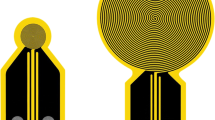Abstract
A new microwave technique for measuring the transient gasification rate is described. A feature of the technique is that the mass loss during gasification is determined based on measurements of the time-varying resonant frequency of the microwave resonator with the test sample by sequentially recording the resonant characteristics of the sensor. This ensures independence of the measurement results from the change in the Q-value of the resonator during gasification of the propellant sample. A sensor prototype which is a coaxial resonator in which the sample under study is placed in the region of maximum electric field has been tested. Experiments have shown that the sensitivity (the ratio of the change in resonant frequency to the change in the inner diameter of the sample) of the new sensor design is two to four times higher than that of the previous sensor model.












Similar content being viewed by others
REFERENCES
V. E. Zarko and K. K. Kuo, “Critical Review of Methods for Regression Rate Measurements of Condensed Phase Systems," Int. J. Energ. Mater. Chem. Propul. 3 (1–6) 600–623 (1994); DOI: 10.1615/IntJEnergeticMaterialsChemProp.v 3.i1-6.590.
V. F. Mikheev, V. E. Zarko, S. M. Borin, K. P. Kutsenogii, and V. N. Simonenko, “Measurement of Burning Rates in Transient Combustion Processes under Influence of External Radiation," Prog. Astronaut. Aeronaut. 63, 173–187 (1976); DOI: 10.2514/5.9781600865374.0173.0187.
V. E. Zarko, “Fundamentals of Transient Combustion of Solid Propellants," Doct. Dissertation in Phys. and Math. Sci. (Inst. of Chem. Kinet. and Combust., Sib. Branch, USSR Acad. of Sci., Novosibirsk, 1984).
V. S. Abrukov, A. E. Averson, and V. M. Mal’tsev, “New Possibilities of Investigating the Combustion Processes of Condensed Systems by Interferometry," Fiz. Goreniya Vzryva 19 (5), 66–69 (1983) [Combust., Expl., Shock Waves 19 (5), 594–596 (1983); https://doi.org/10.1007/BF00750431].
R. A. Frederick (Jr.), “Measuring the Regression of a Burning Solid Propellant," Rev. Scient. Instrum. 67 (8) 2903–2909 (1996); DOI: 10.1063/1.1147070.
N. Eisenreich, H. P. Kugler, and F. Sinn, “An Optical System for Measuring the Burning Rate of Solid Propellant Strands," Propell., Explos., Pyrotech. 12, 78–80 (1987).
J. Wang, Z. Gao, and B. Sang, “Laser Technology for Measurement of Solid Propellant Transient Burning Rates during Rapid Depressurization," Fuel 80 (2) 263–271 (2001); DOI: 10.1016/S0016-2361(00)00087-9.
J. J. Murphy and H. Krier, “Evaluation of Ultrasound Technique for Solid-Propellant Burning Rate Response Measurements," J. Propul. Power 18 (3) 641–651 (2002); DOI: 10.2514/2.5978.
Y. Xiao, R. S. Amano, T. Cai, J. Li, and G. He, “Particle Velocity on Solid-Propellant Surface Using X-Ray Real-Time Radiography," AIAA J. 41 (9) 1763–1770 (2003); DOI: 10.2514/2.7294.
L. D. Strand, K. R. Magiawala, and R. P. McNamara, “Microwave Measurement of the Solid-Propellant Pressure-Coupled Response Function," J. Spacecraft Rockets 17 (6) 483–488 (1980); DOI: 10.2514/3.57768.
A. B. Kiskin, V. E. Zarko, and A. C. Mamaev, “Small Force Transducer with Extended Frequency Range and Compensation Environmental Disturbances," Gorenie Plasmokhim. 14 (4), 279–284 (2016).
V. V. Perov, V. E. Zarko, and A. S. Zhukov, “New Microwave Method for Measuring Unsteady Mass Gasification Rates of Condensed Systems," Fiz. Goreniya Vzryva 50 (6) 130–133 (2014) [Combust., Expl., Shock Waves 50 (6), 739–741 (2014). https://doi.org/10.1134/S0010508214060173].
V. Zarko, V. Perov, A. Kiskin, and D. Nalivaichenko, “Microwave Resonator Method for Measuring Transient Mass Gasification Rate of Condensed Systems," Acta Astronaut. 158, 272–276 (2019); DOI: 10.1016/j.actaastro.2019.03.028.
V. E. Zarko, A. B. Kiskin, and D. G. Nalivaichenko, “Mass Gasification Rate Measurement System," RU Patent No. 189669 U1, Publ. May 30, 2019; https:// www1.fips.ru/nregisters-doc-view/fips_servlet? DB=RUPM&rn=127&DocNumber=189669&TypeFile=html.
V. Zarko, V. Perov, V. Zvegintsev, and D. Nalivaichenko, “New Method for Measuring Transient Mass Gasification Rate of Condensed Systems," in 56th Israel Annu. Conf. on Aerospace Sci. (2016).
Author information
Authors and Affiliations
Corresponding author
Additional information
Translated from Fizika Goreniya i Vzryva, 2022, Vol. 58, No. 5, pp. 87-95.https://doi.org/10.15372/FGV20220511.
Rights and permissions
About this article
Cite this article
Podshivalov, A.I., Grishin, Y.A., Kiskin, A.B. et al. Improved Microwave Method for Measuring the Dynamic Parameters of Gasification of Condensed Materials. Combust Explos Shock Waves 58, 585–592 (2022). https://doi.org/10.1134/S0010508222050112
Received:
Revised:
Accepted:
Published:
Issue Date:
DOI: https://doi.org/10.1134/S0010508222050112




